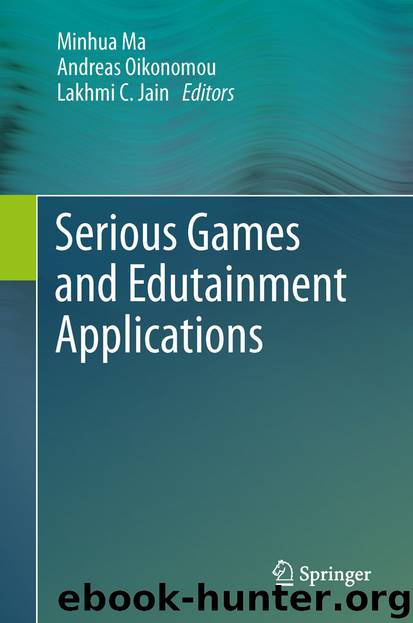Serious Games and Edutainment Applications by Minhua Ma Andreas Oikonomou & Lakhmi C. Jain

Author:Minhua Ma, Andreas Oikonomou & Lakhmi C. Jain
Language: eng
Format: epub
Publisher: Springer London, London
13.2 Background and Related Work
Our research focuses on recognising and responding to emotions effectively in a game-based learning environment , which will ensure students’ learning and understanding and hold students’ interest and motivation. To achieve this endeavour, it is necessary to be aware of existing approaches and the challenges involved.
13.2.1 Challenges of Emotional Game-Based Learning Environments
Advances in psychology, cognitive science, multimodal applications, neuroscience, cinematography and artificial intelligence (AI) have promised dramatic changes in computer tutoring. Research efforts have focused mainly on two main challenges: achieving the most accurate perception of students’ needs and responding in the most suitable manner to these needs in order to nurture and grasp students’ knowledge, understanding, motivation, attention and interest (Du Boulay and Luckin, 2001). When ITSs were incorporated into game-based learning environments to offer adaptable instruction and ensure the achievement of specific learning goals (Blanchard and Frasson, 2006; Conati and Maclaren, 2009), the learning environments inherited these challenges.
Student modelling is an area focused on achieving an abstract knowledge representation of the student (Woolf, 2009). Research focused first on the representation of students’ cognitive state. Clancey and Buchanan (1982) noted that students’ errors were related to students’ misconceptions about domain knowledge and endeavoured to represent teaching and problem solving knowledge in the GUIDON ITS. Research has also attempted to characterize students’ learning styles (Jungclaus et al., 2003) and more recently, students’ personality traits, attitudes (Arroyo and Woolf, 2005), motivation (Del Soldato and Du Boulay, 1995; Rebolledo-Mendez et al., 2006), self-efficacy (McQuiggan et al., 2008) and affect and emotion (Conati and Maclaren, 2009; D’Mello et al., 2008; Sarrafzadeh et al., 2008). AI techniques, such as semantic nets, rules, constraints, plan recognition and machine learning, are applied to make computers capable of reasoning about knowledge (Woolf, 2009).
The interest in researching the influence of emotion in education has been relatively recent and still not completely known (Pekrun et al., 2007; Picard et al., 2004). It is noted that diverse factors influence the presence and communication of people’s emotion, e.g. personality traits, attitudes, preferences, goals and cultural and social conventions. Hence, an expert human identifies affect or emotion with approximately 70% accuracy (Robson, 1993). In an attempt to identify the relevant factors that determine relevant affective and emotional states, researchers computing have focused on observing, annotating, recording and analysing students and lecturers’ interactions (Alexander and Sarrafzadeh, 2008; D’Mello et al., 2008) or reviewing research in education and cognitive psychology (Conati and Maclaren, 2009; Del Soldato and Du Boulay, 1995). It is important to emphasise that there is not a universal classification of emotion (Ortony et al., 1990). Additionally, the context where emotion arises influences the type of emotions that are frequently observed (Pekrun et al., 2007). Therefore, determining the emotions relevant to the specific learning experience also constitutes a challenge.
Two key features that must be accomplished by computer tutoring, in order to effectively adapt to students, are: (1) effectiveness of representing and handling domain knowledge to achieve flexibility in different teaching situations and (2) believability of the communication of pedagogical responses (Lester et al.
Download
This site does not store any files on its server. We only index and link to content provided by other sites. Please contact the content providers to delete copyright contents if any and email us, we'll remove relevant links or contents immediately.
Algorithms of the Intelligent Web by Haralambos Marmanis;Dmitry Babenko(8529)
Test-Driven Development with Java by Alan Mellor(7438)
Data Augmentation with Python by Duc Haba(7331)
Principles of Data Fabric by Sonia Mezzetta(7076)
Learn Blender Simulations the Right Way by Stephen Pearson(7020)
Microservices with Spring Boot 3 and Spring Cloud by Magnus Larsson(6836)
RPA Solution Architect's Handbook by Sachin Sahgal(6252)
Hadoop in Practice by Alex Holmes(6038)
The Infinite Retina by Robert Scoble Irena Cronin(5952)
Jquery UI in Action : Master the concepts Of Jquery UI: A Step By Step Approach by ANMOL GOYAL(5878)
Big Data Analysis with Python by Ivan Marin(5743)
Life 3.0: Being Human in the Age of Artificial Intelligence by Tegmark Max(5410)
Pretrain Vision and Large Language Models in Python by Emily Webber(4702)
Infrastructure as Code for Beginners by Russ McKendrick(4482)
WordPress Plugin Development Cookbook by Yannick Lefebvre(4213)
Functional Programming in JavaScript by Mantyla Dan(4129)
The Age of Surveillance Capitalism by Shoshana Zuboff(4126)
Embracing Microservices Design by Ovais Mehboob Ahmed Khan Nabil Siddiqui and Timothy Oleson(4004)
Applied Machine Learning for Healthcare and Life Sciences Using AWS by Ujjwal Ratan(3981)
